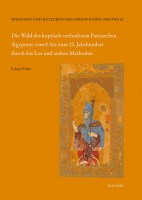Search
Die Wahl des koptisch-orthodoxen Patriarchen Ägyptens vom 8. bis zum 13. Jahrhundert durch das Los und andere Methoden
2024
17.0 x 24.0 cm, 232 p., illustrations b/w, hardback
ISBN: 9783752005943
17.0 x 24.0 cm, 232 p., illustrations b/w, hardback
98,00 €
ISBN: 9783752005943
Short Description
The election of a suitable successor to a deceased patriarch of the Coptic Orthodox Church of Egypt always marks an important turning point in the everyday life of this oriental church. Since 1957, its head has been chosen by lot - an altar lot is drawn from the names of three previously duly elected candidates in order to determine the new Coptic Orthodox patriarch.While the drawing of lots has been a regular feature of the election process since 1957, this selection method has historically been the exception to the rule. To date, only 7 of the 118 Coptic Orthodox patriarchs have been elected by drawing lots. Between the 8th and 13th centuries, there were only two. This is actually astonishing, as the Copts could basically refer to Acts 1:15 - 26 as a relevant precedent for the application of this selection method: After the death of the traitor Judas, a successor had to be found for him. The assembled disciples prayed about this and nominated two men, Joseph and Matthias, as suitable successors. Lots were then cast for them - the choice fell on Matthias, who was henceforth counted among the apostles.
According to the research programme of the Münster Collaborative Research Centre 1150 "Cultures of Decision-Making", drawing lots is considered an "extreme case of decision-making", which makes the application of this selection method extremely presuppositional. So why, in the few cases that have come down to us, did the Copts agree to select the head of their church by drawing lots? What historical and cultural conditions made the use of casting lots as a selection method possible in the first place? What considerations spoke in favour of drawing lots and against the use of other selection methods? And how did these considerations influence the technical-instrumental side as well as the symbolic-expressive side of the drawing of an altar lot used in the individual cases?
A systematic, historical-comparative analysis of the application of both the drawing of lots and other selection methods in the context of the election of the Coptic Orthodox patriarch was a desideratum that had not yet been realised. This study now fulfils this requirement for those patriarchs who were brought to office by drawing lots between the 8th and 13th centuries. Of course, this also includes the other selection methods that can be documented for the regulation of the succession of a deceased patriarch during this period.
Description
The election of a suitable successor to a deceased patriarch of the Coptic Orthodox Church of Egypt always marks an important turning point in the everyday life of this oriental church. Since 1957, its head has been chosen by lot - an altar lot is drawn from the names of three previously duly elected candidates in order to determine the new Coptic Orthodox patriarch.While the drawing of lots has been a regular feature of the election process since 1957, this selection method has historically been the exception to the rule. To date, only 7 of the 118 Coptic Orthodox patriarchs have been elected by drawing lots. Between the 8th and 13th centuries, there were only two. This is actually astonishing, as the Copts could basically refer to Acts 1:15 - 26 as a relevant precedent for the application of this selection method: After the death of the traitor Judas, a successor had to be found for him. The assembled disciples prayed about this and nominated two men, Joseph and Matthias, as suitable successors. Lots were then cast for them - the choice fell on Matthias, who was henceforth counted among the apostles.
According to the research programme of the Münster Collaborative Research Centre 1150 "Cultures of Decision-Making", drawing lots is considered an "extreme case of decision-making", which makes the application of this selection method extremely presuppositional. So why, in the few cases that have come down to us, did the Copts agree to select the head of their church by drawing lots? What historical and cultural conditions made the use of casting lots as a selection method possible in the first place? What considerations spoke in favour of drawing lots and against the use of other selection methods? And how did these considerations influence the technical-instrumental side as well as the symbolic-expressive side of the drawing of an altar lot used in the individual cases?
A systematic, historical-comparative analysis of the application of both the drawing of lots and other selection methods in the context of the election of the Coptic Orthodox patriarch was a desideratum that had not yet been realised. This study now fulfils this requirement for those patriarchs who were brought to office by drawing lots between the 8th and 13th centuries. Of course, this also includes the other selection methods that can be documented for the regulation of the succession of a deceased patriarch during this period.




 Preface
Preface

 Neuerscheinungen 2023/2024
Neuerscheinungen 2023/2024
 Gesamtverzeichnis 2023/2024
Gesamtverzeichnis 2023/2024
 Katalog Oriental Studies & Linguistics
Katalog Oriental Studies & Linguistics
 Mittelalter
Mittelalter
 Deutsche Inschriften
Deutsche Inschriften
 Musiktherapie
Musiktherapie
 Literaturen im Kontext
Literaturen im Kontext